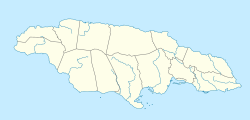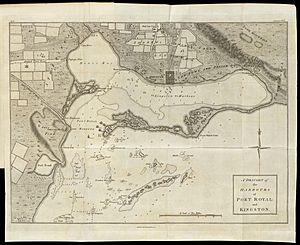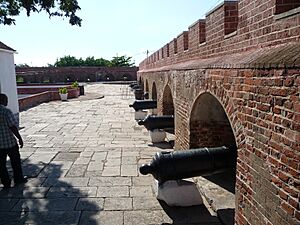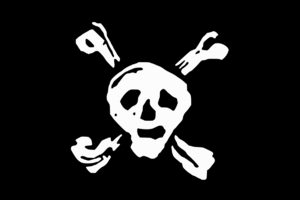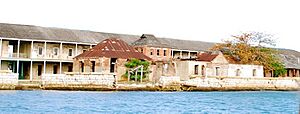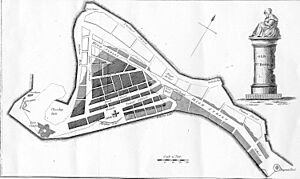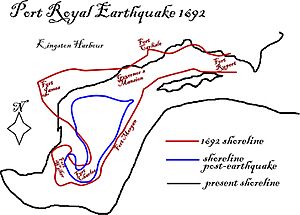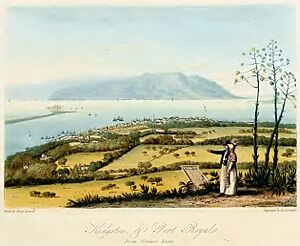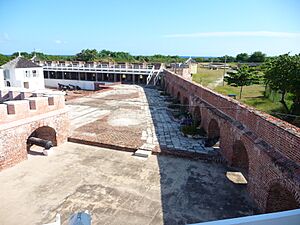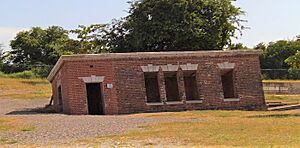Port Royal facts for kids
Quick facts for kids
Port Royal
Puot Rayal
|
|
|---|---|
|
City
|
|
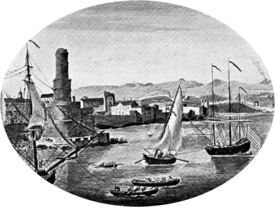
An illustration of pre-1692 Port Royal
|
|
| Country | Jamaica |
| Parish | Kingston |
| Founded | 1494 |
| Destroyed | 1692 |
| Official name: The Archaeological Ensemble of 17th Century Port Royal | |
| Type: | Cultural |
| Criteria: | iv, vi |
| Designated: | 2025 |
| Reference #: | 1595 |
| UNESCO region: | Latin America and the Caribbean |
Port Royal (Jamaican Patois: Puot Rayal) was a historic town in southeastern Jamaica. It was located at the end of the Palisadoes peninsula, at the mouth of Kingston Harbour. The Spanish founded Port Royal in 1494.
For a time, it was the largest and richest city in the Caribbean. It served as a major center for shipping and trade in the 17th century. However, a powerful earthquake on 7 June 1692 and a tsunami destroyed much of the city. This disaster led to the growth of Kingston, which became Jamaica's capital. The area has also faced damage from many severe hurricanes and another major earthquake in 1907.
Port Royal became a home base for English and Dutch privateers. These were sailors hired by governments to attack Spanish ships. Many European nations did not want to directly challenge the strong Spanish fleet. The city became famous for its wealth. Privateer crews spent their riches in the many taverns and shops.
Later, when governments stopped hiring privateers, many sailors became pirates. They continued to use Port Royal as their main base in the 17th century. Pirates from all over the world gathered there. The town earned a reputation in stories as "the wickedest city on Earth."
After the 1692 disaster, Kingston took over Port Royal's role as a trade hub. In 1999, plans began to turn the small fishing town into a heritage tourism spot. The goal was to highlight Port Royal's unique history and archaeological finds. These discoveries from its early years and pirate era could become exciting attractions. In 2025, UNESCO recognized Port Royal as a World Heritage Site.
Contents
Understanding Port Royal's Climate
Port Royal experiences a tropical savanna climate. This means it has a short dry season from January to April. A longer wet season lasts from May to October. Temperatures stay fairly steady all year. January is slightly cooler at about 25.5°C (78°F). May is a bit warmer at 27.7°C (82°F). The area receives about 1345 millimeters (53 inches) of rain each year.
Exploring Port Royal's Past
The Taino people, who were the first inhabitants of the Caribbean, lived in this area for many centuries. They called the spot Caguay or Caguaya. The Taino used the area for fishing trips. While they lived in other parts of Jamaica, it is not known if they settled permanently in Port Royal itself.
Spanish Arrival and Early Settlement
Christopher Columbus led the Spanish when they first arrived in Jamaica in 1494. This arrival greatly impacted the Taino people. Permanent Spanish settlement began in 1509 when Juan de Esquivel brought new settlers. They hoped to find gold and silver. Instead, they started growing and processing sugar cane.
Like the Taino, the Spanish did not use the Port Royal area much. However, they kept its Taino name. Spain controlled Jamaica mainly to stop other countries from using the island. Jamaica was in a very important location along Caribbean trade routes. Spain ruled the island for 146 years. Then, the English took control after an invasion in 1655.
The English captured the town in 1655. By 1659, about 200 houses, shops, and warehouses had been built. By 1692, five forts protected the port. The English first called the place Cagway, but soon renamed it Port Royal. For a long time, Port Royal was Jamaica's unofficial capital. Spanish Town was the official capital. In 1872, Kingston became the official capital.
The Era of Privateers and Pirates
Port Royal offered a safe place for privateers and later for pirates. These groups traveled the shipping lanes to and from Spain and Panama. Buccaneers liked Port Royal for several reasons. It was close to trade routes, making it easy to find ships to capture. The port was also near important passages to the Spanish Main.
The harbor was large enough for many ships. Its shallow waters were perfect for repairing vessels. Port Royal was also a great starting point for attacks on Spanish settlements. From here, Christopher Myngs attacked Campeche. Henry Morgan launched raids on Panama, Portobello, and Maracaibo. Other famous buccaneers like Roche Brasiliano also used Port Royal as their base.
In 1657, Governor Edward D'Oyley invited the Brethren of the Coast to Port Royal. This group of pirates, originally cattle hunters, had turned to piracy after conflicts with the Spanish. They focused their attacks on Spanish shipping. This helped protect the town from Spanish threats.
English privateers received special permission, called "letters of marque," from Jamaica's governor. Around the same time, England began attacking Spanish ships and towns. By using privateers, England created a defense system for Port Royal. Spain had to constantly defend its own lands. This left them unable to retake Jamaica.
Spain could not regain control of the island. Because of the privateers, Spain struggled to send goods to its colonies. This led to Port Royal's growth. Merchants and privateers worked together in what was called "forced trade." Merchants would support trade with the Spanish. They also sponsored privateers to attack Spanish ships and towns. This made Port Royal very wealthy.
Historian Nuala Zahedieh noted that Port Royal's wealth came from serving privateers. She wrote that the 1668 raid on Portobello brought in £75,000. This was more than seven times the annual value of Jamaica's sugar exports at the time. Many people in Port Royal had a stake in privateering. This trade made Port Royal one of the richest English communities in North America.
The English governors often relied on pirates to defend the city. By the 1660s, Port Royal became known as a "pirate utopia." It gained a reputation as the "Sodom of the New World." Many residents were pirates or adventurers. The city was famous for its lively atmosphere and wealth.
At its peak, Port Royal had many taverns. In July 1661 alone, 40 new tavern licenses were issued. By 1692, nearly 10,000 people lived there. The city had goldsmiths, merchants, and artisans. About 2,000 buildings were packed into a small area. In 1688, 213 ships visited the port. The city was so rich that people preferred coins over trading goods.
After Henry Morgan became lieutenant governor, Port Royal started to change. Pirates were no longer needed for defense. Other forms of trade became more important. Many citizens wanted to improve the city's reputation. In 1687, Jamaica passed anti-piracy laws. Port Royal then became known as a place where pirates were brought to justice. Many were executed at Gallows Point. This included Charles Vane and John Rackham, who were executed in 1720.
Under British rule, the Royal Navy used a special wharf at Port Royal for ship repairs. They also rented a building for storage. From 1675, a Naval Officer managed these facilities. However, the 1692 earthquake stopped further development. After the earthquake, there was an attempt to build a naval base at Port Antonio. But the climate there was not suitable.
From 1735, the Admiralty (the British Navy's governing body) focused on Port Royal again. New wharves and storehouses were built. Housing for officers was also constructed. Over the next 30 years, more facilities were added. These included workshops and places for ship crews. A Royal Naval Hospital was also built. By the late 1700s, a small supply yard was added.
In the early 1800s, the Royal Navy Dockyard was rebuilt and expanded. It served the British fleet in the Caribbean. A large storehouse with a clocktower became the main building. The dockyard continued to grow to support steam-powered vessels. A coaling depot was added in the 1840s. An engineering complex followed 20 years later. The dockyard expanded until the early 1900s. The Navy then left Jamaica, and the Dockyard closed in 1905.
Many of the dockyard buildings were made of wood. They were later destroyed by the 1907 Kingston earthquake or Hurricane Charlie in 1951. A few buildings still stand today. These include parts of the Naval Hospital and some officers' houses. A slipway, built in 1904, was used for torpedo boats. In 2014, plans were announced to restore some hospital buildings. They would become a museum as part of a tourism project.
The Great Earthquake of 1692
By 1692, Port Royal had grown very quickly. It had about 6,500 people and 2,000 homes. As building space ran out, people started filling in water areas to build more. Buildings also became taller and heavier. Residents began using brick-style homes, like those in England. Some people suggested building low, wooden homes like the Spanish had. But many did not listen. All these factors contributed to the coming disaster.
On 7 June 1692, a massive earthquake struck Port Royal. Most of the northern part of the city was lost. Many houses and buildings were destroyed. Several forts also collapsed. Fort Charles survived, but Forts James and Carlisle sank into the sea. Fort Rupert became covered by water. A section known as Morgan's Line was also badly damaged.
The earthquake affected all of Jamaica. But Port Royal's citizens faced greater danger. They were threatened by shifting sand, falling buildings, and a tsunami. Many people died from the earthquake and tsunami. Between 1,000 and 3,000 people were killed. This was nearly half of the city's population. In the following months, illnesses spread widely. An estimated 2,000 more people died.
The exact time of the 1692 earthquake is known. In the 1960s, a pocket watch was found on the seafloor. It had stopped at 11:43 a.m., marking the moment of the disaster.
The earthquake caused the sand beneath Port Royal to liquefy. This means the sand became like quicksand and flowed into Kingston Harbour. The town was built on a layer of water-saturated sand. This type of ground was not a strong foundation for a city. The English had chosen to build on this "hot loose sand."
Scientists and underwater archaeologists believe the earthquake was very powerful. Much of the damage came from liquefaction. This happens when earthquakes hit loose, sandy, wet ground. The water pressure increases, making the sand particles separate. Eyewitnesses reported buildings sliding into the water. Some likely sank straight down into the unstable ground.
Underwater archaeology has revealed building foundations beneath the sea. This shows how parts of the city sank. Comparisons of maps from before and after the earthquake also confirm this.
Attempts were made to rebuild the city. But these efforts faced many challenges. A fire destroyed an early rebuilding effort in 1703. Several hurricanes in the 18th century also caused damage. These included sea flooding in 1722 and another fire in 1750. A major hurricane struck in 1774. Soon, Kingston became more important than Port Royal. In 1815, another fire destroyed repairs. The island also suffered a cholera epidemic in 1850.
The 1907 Earthquake and Modern Port Royal
On 14 January 1907, another earthquake struck. It again liquefied the sand spit. This destroyed almost all of the rebuilt city. More parts of Port Royal sank. The Giddy House, an old artillery storage room, was tilted. Today, it is a small tourist attraction.
Port Royal is now much smaller than it once was. It has fewer than 2,000 residents. It holds little commercial or political importance. Tourists visit the area, but it is in need of repair. The Jamaican government plans to develop the area further. They want to highlight its history and attract more visitors.
In 1981, Texas A&M University began a 10-year underwater archaeology project. They explored the part of Port Royal that sank in the 17th century. This area had very low oxygen levels. This helped preserve many organic materials. The project's findings have helped scientists understand daily life in the colonial port city.
In 1998, a master plan was created to redevelop Port Royal. The plan focused on a 17th-century themed attraction. It would reflect the city's rich heritage. The plan included a cruise ship pier and waterfront cafes. It also proposed a shipbuilding museum and an underwater aquarium. This would show the local marine life. The plan also included a five-star hotel.
By 2019, a floating pier for cruise ships was built. The first ship arrived on 20 January 2020. More tourists could help the town. A BBC Travel report in September 2020 noted that much work is still needed. The goal is to make Port Royal a "world-class heritage, environmental and cultural attraction." A well-funded Living Heritage Programme is working to make the town a smart, safe, and secure community. It aims for a strong local economy, preserved heritage, and protected environment.
Today, archaeologists call Port Royal "the City That Sank."


